Related Research Articles

Citrus is a genus of flowering trees and shrubs in the rue family, Rutaceae. Plants in the genus produce citrus fruits, including important crops such as oranges, lemons, grapefruits, pomelos, and limes. The genus Citrus is native to South Asia, East Asia, Southeast Asia, Melanesia, and Australia. Various citrus species have been used and domesticated by indigenous cultures in these areas since ancient times. From there its cultivation spread into Micronesia and Polynesia by the Austronesian expansion ; and to the Middle East and the Mediterranean via the incense trade route, and onwards to Europe and the Americas.
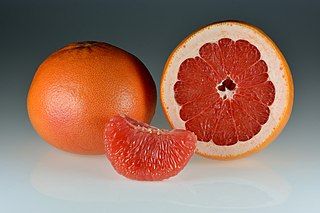
The grapefruit is a subtropical citrus tree known for its relatively large, sour to semi-sweet, somewhat bitter fruit. The interior flesh is segmented and varies in color from pale yellow to dark pink/red.

A lime is a citrus fruit, which is typically round, green in color, 3–6 centimetres (1.2–2.4 in) in diameter, and contains acidic juice vesicles.

Flavonoids are a class of polyphenolic secondary metabolites found in plants, and thus commonly consumed in the diets of humans.
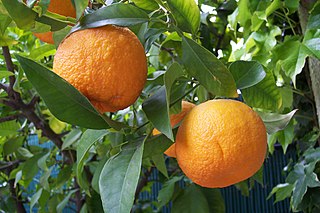
Bitter orange, sour orange, Seville orange, bigarade orange, or marmalade orange is the citrus tree Citrus × aurantium and its fruit. It is native to Southeast Asia and has been spread by humans to many parts of the world. It is probably a cross between the pomelo, Citrus maxima, and the mandarin orange, Citrus reticulata.

The pomelo, from the family Rutaceae, is the largest citrus fruit, and the principal ancestor of the grapefruit. It is a natural, non-hybrid, citrus fruit, native to Southeast Asia. Similar in taste to a sweet grapefruit, the pomelo is commonly consumed and used for festive occasions throughout Southeast Asia. As with the grapefruit, phytochemicals in the pomelo have the potential for drug interactions.

Lovastatin, sold under the brand name Mevacor among others, is a statin medication, to treat high blood cholesterol and reduce the risk of cardiovascular disease. Its use is recommended together with lifestyle changes. It is taken by mouth.

Juicing is the process of extracting juice from plant tissues such as fruit or vegetables.
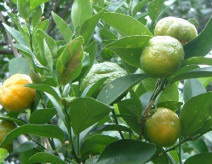
Citrus depressa (Citrus × depressa, formerly C. pectinifera, Okinawan: シークヮーサー/シークァーサー, romanized: shiikwaasa, Japanese: ヒラミレモン, romanized: hirami remon or シークワーサー, shiikuwāsā, in English sometimes called shiikuwasha, shequasar, Taiwan tangerine, Okinawa lime, flat lemon, hirami lemon, or thin-skinned flat lemon, is a small citrus fruit often harvested and used when green, rich in flavonoids and native to East Asia.

Grapefruit juice is the juice from grapefruits. It is rich in vitamin C and ranges from sweet-tart to very sour. Variations include white grapefruit, pink grapefruit and ruby red grapefruit juice.

Naringenin is a flavorless, colorless flavanone, a type of flavonoid. It is the predominant flavanone in grapefruit, and is found in a variety of fruits and herbs.

Naringin is a flavanone-7-O-glycoside between the flavanone naringenin and the disaccharide neohesperidose. The flavonoid naringin occurs naturally in citrus fruits, especially in grapefruit, where naringin is responsible for the fruit's bitter taste. In commercial grapefruit juice production, the enzyme naringinase can be used to remove the bitterness created by naringin. In humans naringin is metabolized to the aglycone naringenin by naringinase present in the gut.

Hesperidin is a flavanone glycoside found in citrus fruits. Its aglycone form is called hesperetin. Its name is derived from the word "hesperidium", for fruit produced by citrus trees.
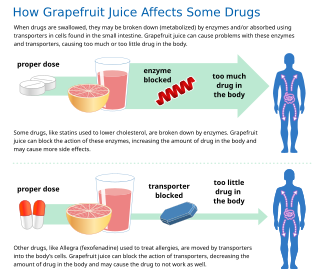
Some fruit juices and fruits can interact with numerous drugs, in many cases causing adverse effects. The effect is most studied with grapefruit and grapefruit juice, but similar effects have been observed with certain other citrus fruits.
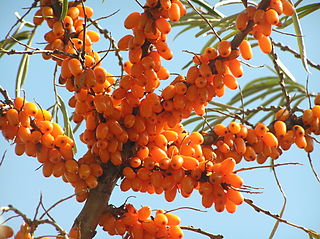
Sea buckthorn oil is a red-orange oil derived from sea buckthorn plants. The most commonly used species for this purpose is Hippophae rhamnoides. Species belonging to this genus accumulate lipids in the mesocarp, so the oil can be extracted from either the seeds or the pulp.

Flavonols are a class of flavonoids that have the 3-hydroxyflavone backbone. Their diversity stems from the different positions of the phenolic –OH groups. They are distinct from flavanols such as catechin, another class of flavonoids.

The phenolic content in wine refers to the phenolic compounds—natural phenol and polyphenols—in wine, which include a large group of several hundred chemical compounds that affect the taste, color and mouthfeel of wine. These compounds include phenolic acids, stilbenoids, flavonols, dihydroflavonols, anthocyanins, flavanol monomers (catechins) and flavanol polymers (proanthocyanidins). This large group of natural phenols can be broadly separated into two categories, flavonoids and non-flavonoids. Flavonoids include the anthocyanins and tannins which contribute to the color and mouthfeel of the wine. The non-flavonoids include the stilbenoids such as resveratrol and phenolic acids such as benzoic, caffeic and cinnamic acids.

The juice vesicles, also known as citrus kernels, of a citrus fruit are the membranous content of the fruit's endocarp. All fruits from the Citranae subtribe, subfamily Aurantioideae, and family Rutaceae have juice vesicles. The vesicles contain the juice of the fruit and appear shiny and sacklike. Vesicles come in two shapes: the superior and inferior, and these are distinct. Citrus fruit with more vesicles generally weighs more than those with fewer vesicles. Fruits with many segments, such as the grapefruit or pomelo, have more vesicles per segment than fruits with fewer segments, such as the kumquat and mandarin. Each vesicle in a segment in citrus fruits has approximately the same shape, size, and weight. About 5% of the weight of an average orange is made up of the membranes of the juice vesicles.

The lemon is a species of small evergreen tree in the flowering plant family Rutaceae, native to Asia, primarily Northeast India (Assam), Northern Myanmar, or China.

6',7'-Dihydroxybergamottin is a natural furanocoumarin found in pomelos, grapefruits, and sour oranges, in both the peel and the pulp. Along with the chemically related compound bergamottin, it is believed to be responsible for a number of grapefruit–drug interactions, in which the consumption of citrus containing one or both of these compounds affects the metabolism of a variety of pharmaceutical drugs.
References
- 1 2 3 4 5 6 7 8 von Woedtke T, Schlüter B, Pflegel P, Lindequist U, Jülich WD (June 1999). "Aspects of the antimicrobial efficacy of grapefruit seed extract and its relation to preservative substances contained". Pharmazie. 54 (6): 452–6. PMID 10399191.
- 1 2 Ganzera M, Aberham A, Stuppner H (May 2006). "Development and validation of an HPLC/UV/MS method for simultaneous determination of 18 preservatives in grapefruit seed extract". J. Agric. Food Chem. 54 (11): 3768–72. doi:10.1021/jf060543d. PMID 16719494.
- ↑ Dowling, Curtis F.; Morton, Julia Frances (1987). Fruits of warm climates. Miami, Fla: J.F. Morton. pp. 152–8. ISBN 978-0-9610184-1-2.
- ↑ Michael Quinion. World Wide Words: Questions & Answers; Grapefruit. 2009.
- ↑ Fellers PJ, Nikdel S, Lee HS (August 1990). "Nutrient content and nutrition labeling of several processed Florida citrus juice products". J Am Diet Assoc. 90 (8): 1079–84. doi:10.1016/S0002-8223(21)01704-1. PMID 2380455. S2CID 25833812.
- ↑ Worwood, Valerie Ann (1991). The complete book of essential oils and aromatherapy . Novato, Calif: New World Library. ISBN 978-0-931432-82-8.
- ↑ Cerda JJ, Robbins FL, Burgin CW, Baumgartner TG, Rice RW (September 1988). "The effects of grapefruit pectin on patients at risk for coronary heart disease without altering diet or lifestyle". Clin Cardiol. 11 (9): 589–94. doi: 10.1002/clc.4960110902 . PMID 3229016. S2CID 45520617.
- 1 2 3 Scott Gravura (10 March 2016). "Not natural, not safe: Grapefruit seed extract". Science-based Medicine. Retrieved 17 November 2018.
- ↑ Arthington JD, Kunkle WE, Martin AM (July 2002). "Citrus pulp for cattle". Vet. Clin. North Am. Food Anim. Pract. 18 (2): 317–26, vii. doi:10.1016/S0749-0720(02)00023-3. PMID 12235663.
- ↑ Cvetnić Z, Vladimir-Knezević S (September 2004). "Antimicrobial activity of grapefruit seed and pulp ethanolic extract". Acta Pharm. 54 (3): 243–50. PMID 15610620.
- 1 2 3 "Grapefruit". Drugs.com. 15 January 2018. Retrieved 17 November 2018.
- 1 2 Takeoka GR, Dao LT, Wong RY, Harden LA (September 2005). "Identification of benzalkonium chloride in commercial grapefruit seed extracts". J. Agric. Food Chem. 53 (19): 7630–6. doi:10.1021/jf0514064. PMID 16159196.
- ↑ Drewnowski A, Gomez-Carneors C (2000). "Bitter taste, phytonutrients, and consumer: a review". Am. J. Clin. Nutr. 72 (6): 1424–35. doi: 10.1093/ajcn/72.6.1424 . PMID 11101467.
- ↑ Tirillini B (2000). "Grapefruit: the last decade acquisitions". Fitoterapia. 71: 29–37. doi:10.1016/S0367-326X(00)00176-3. PMID 10930710.
- ↑ Bennett RD, Hasegava S, Herman Z (1989). "Glucosides of acidic limonoids in citrus". Phytochemistry. 28 (10): 2777–81. doi:10.1016/S0031-9422(00)98087-7.
- ↑ Ohta H, Fong CH, Berhow M, Hesegawa (1993). "Thin-layer and high-performance liquid chromatographic analyses of limonoids and limonoid glucosides in citrus seeds". J. Chromatogr. 639 (2): 295–302. doi:10.1016/0021-9673(93)80266-B.
{{cite journal}}: CS1 maint: multiple names: authors list (link) - ↑ Tushiswili LS, Durmishidze SV, Sulaberidze KV (1983). "Sterols of grapefruit, orange, mandarin pulps (Citrus paradisi, Citrus sinensis, Citrus unshiu)". Chemistry of Natural Compounds. 18: 445–7. doi:10.1007/BF00579640. S2CID 4814220.
- 1 2 Bailey, D. G.; Dresser, G.; Arnold, J. M. O. (2012). "Grapefruit-medication interactions: Forbidden fruit or avoidable consequences?". Canadian Medical Association Journal. 185 (4): 309–316. doi:10.1503/cmaj.120951. PMC 3589309 . PMID 23184849.